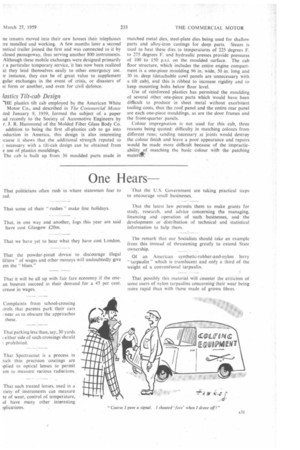Passing Comments
Page 32

Page 33

If you've noticed an error in this article please click here to report it so we can fix it.
Improvers for Light-oil Fuels
MANY people are aware of the widespread use of "I additives in lubricating oils, •but few realize that chemical improvers must be included in present-day petrols to cope with the performance of the modern high-compression engine. Speaking to the Institute of Petroleum in London recently, Mr. C. G. Tresidder gave a concise survey of the gasoline additives commonly in use and their
functions in improving engine performance. • Widely recognized for its anti-knock capabilities tetraethyl-lead had been available since 1923. A problem which had to be overcome with this compound was exhaustvalve failure, caused by corrosive attack from the leadedfuel gas condensates. This had been overcome by the addition of lead-scavenging compounds and changes in engine design.
In addition to tetraethyl-lead, many present-day light-oil fuels contained one or more supplementary chemical substances, including some phosphorous compounds, which were variously aimed at reducing ice formation inside carburetters, preventing uncontrolled ignition resulting from incandescent deposits in the combustion chamber, checking misfiring of sparking plugs due to a build-up of lead on the electrodes and dispersing rust in fuel systems.
Fade Fades
WHEN the Bedford J3 low-loading 4-tonner was road"tested (The Commercial Motor, December 12, 1958) serious brake fade occurred in descending the
gradient of Bison Hill in neutral at 20 m.p.h. with the foot brake applied. The Vauxhall engineers and John F. Moon, A30 who tested the vehicle, were greatly surprised, but could not explain the phenomenon.
It is now known that the Raybestos moulded facings fitted as standard to the vehicle require an appreciably longer period of bedding-in than the facings formerly used. Some 2,500-3,000 miles' running is necessary for really successful operation. When the same lorry was recently tested again under identical conditions with the facings fully bedded-in, a " crash " stop from 20 m.p.h. after the descent produced a Tapley meter reading of 86 per cent., which is, if anything, slightly higher than the maximum Tapley meter figure obtained during the original test with cold drums.
Mobile Telephone Exchanges Meet Need
BRITONS whose names have been for months on the
G.P.O. waiting list for telephones may well envy what a private-enterprise telephone service in the United States is Offering its customers. As in Britain, new housing estates and towns are mushrooming all over America, and until recently were being built much faster than was the supply of telephone equipment. Now, however, the Bell Telephone Co. have solved the problem with what they term the " Mobile Community Dial Office."
This is a telephone exchange on wheels fitted with the Same equipment as any permanent exchange, and comprising an air-conditioned semi-trailer van built by the Highway Trailer Co., of Egerton, Wisconsin. It is of all-steel construction, 37 ft. long, 12+ ft. high and 8 ft. wide, and can handle service for 800 telephones.
For its first trial a concrete slab was laid on land near a new housing area and the van hauled to this site. There it was set up on a frame and the wheels removed. By the
ne tenants moved into their new houses their telephones re installed and working. A few months later a second E:ntical trailer joined the first and was connected to it by closed passageway, thus serving another 800 instruments. Although these mobile exchanges were designed primarily r a particular temporary service, it has now been realized at they lend themselves easily to other emergency use. ).1. instance, they can be of great value to supplement gular exchanges in the event of crisis, or disasters of to form or another, and even for civil defence.
(miles Tilt-cab Design 'HE plastics tilt cab employed by the American White Motor Co„ and described in The Commercial Motor ted January 9, 1959, formed the subject of a paper ad recently to the Society of Automotive Engineers by r. J. R. Hammond of the Molded Fiber Glass Body Co. addition to being the first all-plastics cab to go into oduction in America, this design is also interesting ;cause it shows that the additional strength reputed to necessary with a tilt-cab design can be obtained from e use of plastics mouldings.
The cab is built up from 36 moulded parts made in matched metal dies, steel-plate dies being used for shallow parts and alloy-iron castings for deep parts. Stearn is used to heat these dies to temperatures of 225 degrees F. to 275 degrees F. and hydraulic presses provide pressures of 100 to 150 p.s.i. on the moulded surface, The cab floor structure, which includes the entire engine compartment is a one-piece moulding 96 in. wide, 50 -in. long and 30 in. deep (detachable cowl panels are unnecessary with a tilt cab), and this is ribbed to increase rigidity and to keep mounting bolts below floor level.
Use of reinforced plastics has permitted the moulding of several other one-piece parts which would have been difficult to produce in sheet metal without exorbitant tooling costs, thus the roof panel and the entire rear panel are each one-piece mouldings, as are the door frames and the front-quarter panels.
Colour impregnation is not used for this cab, three reasons being quoted: difficulty in matching colours from different runs; sanding necessary at joints would destroy the colour finish and leave a poor appearance and repairs would be made more difficult because of the impracticability of matching the basic colour with the patching materifk




































































































